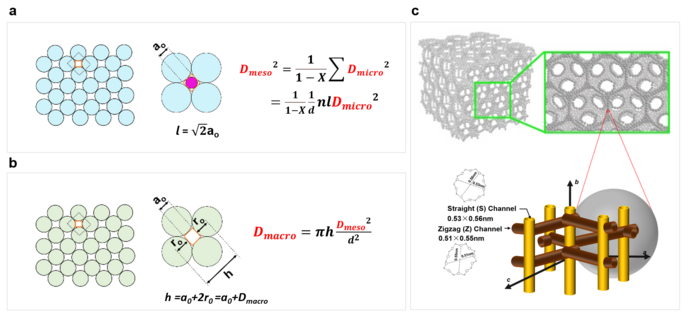Incorporating interconnected mesopores and macropores into microporous zeolites with rationalized pore size at each level is an effective approach for overcoming diffusion limitations. Still, difficulties remain due to a lack of rational design principles.
 The different size ratios between multi-scale pores based on the generalized Murray’s Law. (a) The size ratio between mesopore and micropore. (b) The size ratio between macropore and mesopore and (c) The hierarchically porous structural illustration of OMMM–ZSM-5 zeolites. Image Credit: ©Science China Press.
The different size ratios between multi-scale pores based on the generalized Murray’s Law. (a) The size ratio between mesopore and micropore. (b) The size ratio between macropore and mesopore and (c) The hierarchically porous structural illustration of OMMM–ZSM-5 zeolites. Image Credit: ©Science China Press.
For the first time, the researchers indicated the first instance of enhancing molecular diffusion by creating hierarchical Murray zeolites (OMMM-ZSM-5) with highly ordered and completely interconnected macro-meso-microporous structure gathered by uniform zeolite nanocrystals, directed by the generalized Murray’s Law.
The walls of macropores are made up of highly uniform zeolite nanocrystals, resulting in the formation of an interconnected, ordered mesoporous system.
The temperature-dependent hyperpolarized 129Xe nuclear magnetic resonance revealed the outstanding interconnectivity of the hierarchical Murray structure.
The intelligent gravimetric analysis (IGA), a macroscopic diffusion measurement on the diffusion of 1,3,5-trimethylbenzene was conducted under inert conditions to investigate the mass transfer of bulky molecules within the highly interconnected hierarchical Murray structure of OMMM-ZSM-5.
OMMM-ZSM-5 zeolites had 9.4 times the maximum adsorption amount and nine times the relative diffusion rate of conventional ZSM-5 zeolites.
The 1H pulsed field gradient (PFG) NMR, a microscopic diffusion measurement, was used to investigate the intracrystalline diffusion behavior and the effect of the interconnected and rationalized macro-meso-micropores in expediting diffusion in OMMM-ZSM-5 zeolite. The total diffusivity of molecules (Df-intra) in the hierarchical Murray zeolite was approximately ten times that of the microporous zeolite ZSM-5.
The earlier results demonstrated that the interconnected and rationalized macro-meso-micropores in the hierarchical Murray architecture could significantly accelerate diffusion performance.
Because of its outstanding diffusion property, hierarchical Murray zeolite ZSM-5 is an exceptional solid acid catalyst in the catalytic cracking of 1,3,5-triisopropylbenzene 1,3,5-TIPB.
Hierarchical Murray zeolite outperformed microporous ZSM-5 in terms of catalytic performance and coke deposition by 2.5 times. The presence of an outstanding hierarchical Murray structural diffusion system offers an efficient catalyst, which is encouraging in several organic catalytic reactions involving large molecules.
Murray’s Law generalized could facilitate the dependable and constrained production of bioinspired hierarchically porous materials with optimized structural features and high performance.
Journal Reference:
Sun, M.-H., et al. (2022) Boosting molecular diffusion following the generalized Murray’s Law by constructing hierarchical zeolites for maximized catalytic activity. National Science Review. doi.org/10.1093/nsr/nwac236.